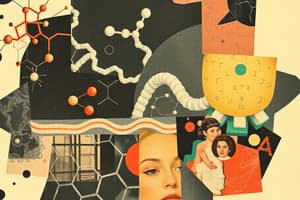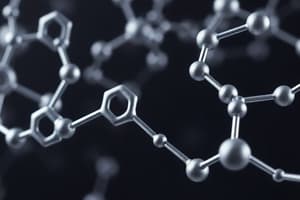Podcast
Questions and Answers
Which of the following amino acids is/are nonpolar?
Which of the following amino acids is/are nonpolar?
- A and B (correct)
- Tyrosine
- Tryptophan
- B and C
- Lysine
What is the distinguishable group or moiety found in arginine’s R group?
What is the distinguishable group or moiety found in arginine’s R group?
- Imidazole
- Thioether
- Indole
- Thiol
- Guanidine (correct)
Which test detects the presence of aromatic amino acids?
Which test detects the presence of aromatic amino acids?
- Sakaguchi Test
- Millon-Nasse Test
- Xanthoproteic Test (correct)
- Ninhydrin Test
Which stabilizes the helical or sheet-like shape of a peptide?
Which stabilizes the helical or sheet-like shape of a peptide?
Process of converting a peptide chain into free amino acids
Process of converting a peptide chain into free amino acids
What is the protein portion of an enzyme called?
What is the protein portion of an enzyme called?
Vitamin B3 deficiency is known as?
Vitamin B3 deficiency is known as?
What is the primary EC number of the enzyme serum glutamate pyruvate transaminase?
What is the primary EC number of the enzyme serum glutamate pyruvate transaminase?
The enzyme that combines acetyl-CoA and carbon dioxide into a longer malonyl-CoA should have an EC number of?
The enzyme that combines acetyl-CoA and carbon dioxide into a longer malonyl-CoA should have an EC number of?
The higher the Km of a substrate, the ________ is its affinity to an enzyme
The higher the Km of a substrate, the ________ is its affinity to an enzyme
Which of the following is true about glycolysis?
Which of the following is true about glycolysis?
Enzymes which catalyze irreversible reactions in glycolysis are:
Enzymes which catalyze irreversible reactions in glycolysis are:
Which of the following is not true?
Which of the following is not true?
FADH2 is formed in which of the following reactions?
FADH2 is formed in which of the following reactions?
Which of the following does NOT yield energy in the citric acid cycle?
Which of the following does NOT yield energy in the citric acid cycle?
Which of the following is true about the electron transport chain?
Which of the following is true about the electron transport chain?
Cyanide and carbon monoxide interfere with what complex, given it is where oxygen lies?
Cyanide and carbon monoxide interfere with what complex, given it is where oxygen lies?
What is the energy yield from anaerobic respiration of one molecule of glucose?
What is the energy yield from anaerobic respiration of one molecule of glucose?
Which of the enzymes involve the reversal of the process done by hexokinase in glycolysis?
Which of the enzymes involve the reversal of the process done by hexokinase in glycolysis?
Which of the following enzymes is responsible for breakdown of α1,4 bonds in glycogen?
Which of the following enzymes is responsible for breakdown of α1,4 bonds in glycogen?
What GSD # involves deficiency of glycogen synthase?
What GSD # involves deficiency of glycogen synthase?
What is the likely name of process 1?
What is the likely name of process 1?
In process 2, what enzyme(s) is/are involved?
In process 2, what enzyme(s) is/are involved?
What is the purpose of the non-oxidative phase of the pentose phosphate pathway?
What is the purpose of the non-oxidative phase of the pentose phosphate pathway?
Which of the following statements is not true about the oxidative phase?
Which of the following statements is not true about the oxidative phase?
Which of the following is FALSE about beta-oxidation?
Which of the following is FALSE about beta-oxidation?
Flashcards are hidden until you start studying
Study Notes
Biochemistry Study Notes
Amino Acid Biochemistry
- The protein portion of an enzyme is called apoenzyme (Q6)
- Arginine's R group has a guanidine group (Q2)
- The correct primary EC number of the enzyme serum glutamate pyruvate transaminase is 2 (Q9)
Carbohydrate Biochemistry
- Glucose oxidation at the first carbon yields gluconic acid (Q17)
- Sucrose is a disaccharide consisting of glucose and fructose (Q14)
- Specific test for galactose is the mucic acid test (Q18)
Lipid Biochemistry
- Saturated fatty acid with 18 C is stearic acid (Q20)
- Lecithin, a major component of cell membranes, is phosphatidylcholine (Q23)
- Esters of long-chain fatty acids with long-chain monohydric alcohols are waxes (Q24)
Nucleic Acid Biochemistry
- The composition of a nucleoside is base + sugar (Q28)
- The direction of genetic information flow during gene expression is DNA → RNA → Protein (Q32)
- In prokaryotes, the ribosomal binding site on the mRNA is called the Shine-Dalgarno sequence (Q42)
Metabolic Pathways
- Glycolysis is a catabolic process that results in the production of ATP and NADH (Q47)
- The citric acid cycle (Krebs cycle) is a series of reactions that produce ATP, NADH, and FADH2 (Q51)
- The electron transport chain is a series of protein complexes that generate ATP from the energy released from NADH and FADH2 (Q52)
Other Topics
- Isoleucine has a pI of 6.02 (Q1)
- Vitamins and their functions:
- Vitamin B7 is needed by the enzyme acetyl CoA carboxylase, which catalyzes the carboxylation of acetyl CoA to malonyl CoA (Q7)
- Vitamin K is necessary for the synthesis of certain clotting factors (Q25)### Metabolic Disorders and Enzymes
- Phenylketonuria is related to phenylalanine.
- Albinism is related to tryptophan.
- MSUD (Maple Syrup Urine Disease) is related to isoleucine, leucine, and alanine.
Cellular Pathways and Enzymes
- The urea cycle does not occur inside the mitochondrion, nor within the mitochondrial membranes.
- The citric acid cycle, beta-oxidation, and oxidative phosphorylation occur inside the mitochondrion, or within the mitochondrial membranes.
- Glycolysis does not occur inside the mitochondrion, nor within the mitochondrial membranes.
- Pyruvate carboxylase catalyzes the reaction: Pyruvate → OAA.
- Pyruvate dehydrogenase complex is not responsible for the reaction: Pyruvate → OAA.
- A deficiency in Pyruvate dehydrogenase can cause lactic acidosis due to pyruvate being shifted towards anaerobic respiration instead of being utilized for the Krebs' cycle.
Studying That Suits You
Use AI to generate personalized quizzes and flashcards to suit your learning preferences.




